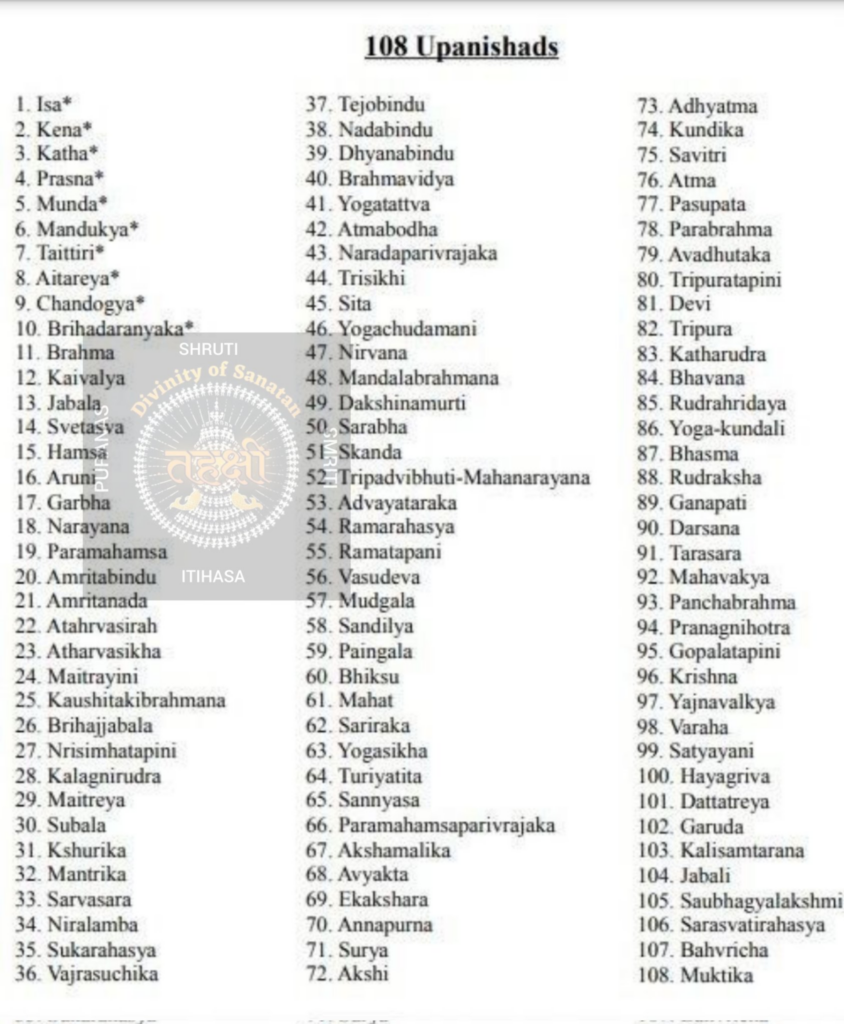Here we provide a direct download link to the ‘108 Upanishads PDF In English’. You can find the download button of the attachment pdf at the end of this article. For information, we have provided – ‘108 Upanishads English’ details like PDF size, PDF language, and PDF demo.
108 Upanishads Name List PDF Free Download

Isavasya Upanishad
- Isaupanishad
- Kenaupanihad
- Kathaupanishad
- Prasnaupanishad
- Mundaupanishad
- Mandukya
- Taittiri
- Aitareyaupanishad
- Chandogyaupanishad
- Brihadaranyakaupanishad
- Brahma
- Kaivalya
- Jabala
- Svetasva
- Hamsa
- Aruni
- Garbha
- Narayana
- Paramahamsa
- Amritabindu
- Amritanada
- Atahrvasirah
- Atharvasikha
- Maitrayini
- Kaushitakibrahmana
- Brihajjabala
- Nrisimhatapini
- Kalagnirudra
- Maitreya
- Subala
- Kshurika
- Mantrika
- Sarvasara
- Niralamba
- Sukarahasya
- Vajrasuchika
- Tejobindu
- Nadabindu
- Dhyanabindu
- Brahmavidya
- Yogatattva
- Atmabodha
- Naradaparivrajaka
- Trisikhi
- Sita
- Yogachudamani
- Nirvana
- Mandalabrahmana
- Dakshinamurti
- Sarabha
- Skanda
- Tripadvibhuti-Mahanarayana
- Advayataraka
- Ramarahasya
- Ramatapani
- Vasudeva
- Mudgala
- Sandilya
- Paingala
- Bhiksu
- Mahat
- Sariraka
- Yogasikha
- Turiyatita
- Sannyasa
- Paramahamsaparivrajaka
- Akshamalika
- Avyakta
- Ekakshara
- Annapurna
- Surya
- Akshi
- Adhyatma
- Kundika
- Savitri
- Atma
- Pasupata
- Parabrahma
- Avadhutaka
- Tripuratapini
- Devi
- Tripura
- Katharudra
- Bhavana
- Rudrahridaya
- Yoga-kundali
- Bhasma
- Rudraksha
- Ganapati
- Darsana
- Tarasara
- Mahavakya
- Panchabrahma
- Pranagnihotra
- Gopalatapini
- Krishna
- Yajnavalkya
- Varaha
- Satyayani
- Hayagriva
- Dattatreya
- Garuda
- Kalisamtarana
- Jabali
- Saubhagyalakshmi
- Sarasvatirahasya
- Bahvricha
- Muktika
The Shabda Brahman: Om
Om is a principal subject in the eleven major upanishads, but the entire Mandukya Upanishad is
dedicated to an explanation of Its meaning for the sadhaka. It wastes no time, but starts right at the
pinnacle, saying:
“The syllable OM, which is the imperishable Brahman, is the universe. Whatsoever has existed, whatsoever exists, whatsoever shall exist hereafter, is OM. And whatsoever transcends past, present, and future, that also is OM.”
(Mandukya Upanishad 1) This is so vast, and yet at the same time so simple, that it renders comment impossible and unnecessary. The essential point is the infinity of Om, because It is the infinite Brahman.
“All this that we see without is Brahman. This Self that is within is Brahman. This Self, which is one with OM, has three aspects, and beyond these three, different from them and indefinable–The Fourth.”
Mandukya Upanishad 2) The three aspects of those within relativity are waking, dreaming sleep, and dreamless sleep. Beyond these three is the pure consciousness itself known as turiya.
This fourth state is the sole state of the liberated consciousness. Even if a liberated being reenters into relative existence for the upliftment of those still caught in that net, he remains consciously centered in turiya and
experiences the three lower states only peripherally.
When the turiya level overwhelms such a one we say he has “gone into samadhi,” but in actuality he has simply become absorbed in his continual state, having momentarily dropped the flimsy dreams of relative existence which we think are so real and binding.
I have heard more than one disciple tell of their having to hold Yogananda up and help him walk when toward the end of his earthly time he was continually flying upward into his true state. Often he would see his body moving along far below, as though he were soaring high in the sky.
“As above, so below” is a fundamental truth of the cosmos. What can be said of the macrocosm can also be said of the microcosm. And since the Infinite and the finite are essentially one, the Upanishad now begins analyzing the three levels of the Cosmic Man.
| Author | – |
| Language | English |
| No. of Pages | 908 |
| PDF Size | 30 MB |
| Category | Religious |
Related PDFs
- छान्दोग्य उपनिषद PDF
- माण्डूक्य उपनिषद PDF
- त्रिपुरा उपनिषद PDF
- श्वेताश्वतर उपनिषद PDF
- ईशावास्योपनिषद PDF
- ईशादी नौ उपनिषद PDF
108 Upanishads Name List PDF Free Download
